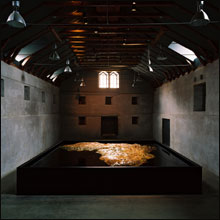
EMERGENCIA: Africa rises and falls in a pool
of dark water.
|
Chilean-born and New York-based artist Alfredo Jaar spoke last week at the University of Southern Maine campus as part of the Nelson Fund for Social Justice project at the Portland Museum of Art. He spoke about his process creating public interventions, walking the audience through one of his best known projects, one concerning the genocide in Rwanda. He sat down with the Portland Phoenix to further discuss his practice.
You’ve described your art as having a goal of elevating consciousness. What does that mean to you?
I’ve always thought that artists are very privileged individuals. That privilege comes from responsibility. Basically, society has given us the time and the resources to think. That’s what I do. I think. I think about the world. I think about society. I think about the way we could make things better. The world of culture is a great way to do that. Maybe, the world of culture is the last open and free space where you can do that.
I try to first inform about a particular situation. That information I offer to the audience through emotions. Information through emotions. I want to move you. I feel incapable of creating a work that is a pure product of my imagination. Everything I’ve done for the last thirty years responds of to a real-life event. I’m not a studio artist; I am a project artist. All these works are projects which develop according to their logic. Ideally, I want the audience to feel connected to the subject. We have to find strategies to connect because people feel removed from these issues.
What is perhaps your ideal elevation of art?
From which you learn about the world in which you live. Each project will have its different objectives. In some works, it will move you to action. The audience reaches a point of information and they go out on their own.
Do you consider your work direct action?
As human beings, in this country, we live a very distanced life from other events. It’s almost a world of fiction. A very privileged world which doesn’t correspond to more than 10 or 15 percent of the rest of the world. Once you get out of here you discover that. I’m trying to bridge these worlds and create awareness that it is all one world. We are all human beings.
In what ways does your work engage the mechanisms of society — socialism, capitalism?
Sometimes it is direct, sometimes it is implied in my work, but it is always there, because there is no outside the system. We participate fully in that system, we have clothes, we have heat, we have projection systems, technology for the museums. I accept that system, but I demand that we are aware that we are within that system. I am always looking for the little cracks because I want to create a sense of balance between reality and that system. The system tries to make you forget reality. That’s what happened with Rwanda because Rwanda was not able to create even a crack in the consciousness of this country so you have Newsweek magazine that for seventeen weeks ignored the killing of one million people. What is it doing by doing that? It is saying that we have to protect the system, the system works fine without paying attention to this. As artists we are looking for these cracks to enter the system in order to say this is part of our world.
You’ve said it took years for you to be happy with the results of the Rwanda project...
I was never happy.
So what were the ways you gathered information about this place and event and processed it into a way you felt was effective as possible?
When I approach a situation like this, I try to understand it as fully as possible so I gather information — talking with people, reading, researching on site, on the internet. I believe that the more information I accumulate, the more successful my projects. When you reach a point where you think you have enough information, you start putting projects out there.
In the case of Rwanda, I felt that it wasn’t possible. The first project failed, the second project failed. From each project I learned a great deal and I applied that lesson to the next project. Each project from the Rwanda project became an essay on representation, different exercises on representation. They were condemned to fail from the beginning. Why did they fail? They were futile from the beginning in the sense that the genocide had already occurred and nobody cared. So why bother, it’s too late. If you’re a little more optimistic, you say, “well I still want to inform people so they understand what happened and we avoid it the next time.” So in spite of this great failure of humankind, Rwanda, there were things we could do to learn from it. My project failed, but it tried to do that, to create a sense of solidarity and to move people. I wanted people to mourn this death. I still think it was worth it to try this exercise.